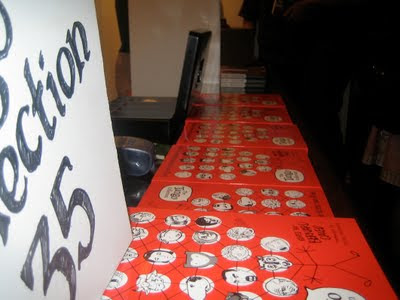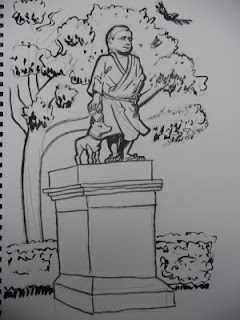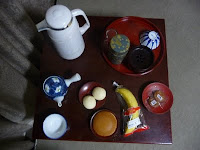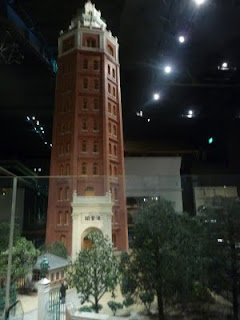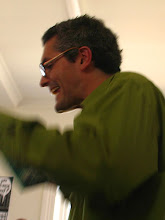Saturday, December 12, 2009
The Double Tango launch at Dante's!
Sunday, December 6, 2009
'The Tango Collection' hits the shelves!
Thursday, November 26, 2009
A Tale of Two Tangos
Koichi incoming!
Monday, November 16, 2009
Edo Tokyo and the Amazon
Sunday, November 8, 2009
Lost in transit(ion)
See you in Australia. Thanks for reading, I've really enjoyed writing this.
'Six views of room 331 at Fukudaya'






Smiling like a loon to cover up the tears.

At Ueno Park this afternoon, my old friends were there in numbers.
Saturday, November 7, 2009
Astro, Lafcadio, and me

Okay, there's one of my odd pan-and-scanimations of the entire frieze at the bottom of this post, or go to this lovely blog where they have much better pictures, as well as the answer to: 'Why Astro? Why here?'

Good costumes too. Anyway, I'd come here to find 'The Blue Parrot', a second hand English language bookshop, and after a false street or so, I did locate it. (It occurred to me for the first time today that actually a compass would be really good in Tokyo, maybe any city but particularly one without street names or street numbers, in order to orient your map at least in the right direction... ah well, next trip)

OVER the Kandagawa River.

UNDER the traffic lights whose horizontality I love so.

Then launched myself into the mega-shopper Saturday afternoon craziness of Ikebukoro - hoo! Everybody alive here! A train to Harajuku Station, another busy throbbing shopping mecca where I managed to find KIDDYLAND (Joseph, Zebedee: does that sound good?) and was dragging my feet back towards the station, when another 'Oasis this way' sign appeared. I followed it, and found myself in a pair of white slippers and the 'Ukiyoe Ota Memorial Museum of Art' - a perfect follow-up to yesterday's shin-hanga experience. This museum changes over the pieces that they display EVERY MONTH (imagine that, my curatorial friends), and at the moment the show's focus is on plants, flowers and gardening and its place in old Edo town. Sounds so-so: was fantastic. And was a great intro, for me, to the work of Utagawa Hiroshige (1797 - 1858) -- far and above the pick of the artists on display. Every time a piece hit me with design, colour, particularly composition, I'd bet myself it was a Hiroshige and it would be.

Saturday night in Shibuya. My last night in Tokyo, at least for a while. I feel like I've only scratched the surface of the facet of the dermis of the mantle (of course).
Friday, November 6, 2009
Every haiku leaf that falls
And it looks a little like this:
On one of the nights that we were out with Nahoko from Miraikan, she recommended the Edo-Tokyo Museum as a good place to visit. I had already starred it in my pre-Japan Time Out and Lonely Planet guidebook scanning (thanks Torie, Hayden, Luke) and today was the day.
On the way out of the station I saw this poster and thought, oboy. I really hope THAT exhibition is on at the Edo Tokyo. And you know what?
It was.
This is the Edo-Tokyo museum. Pretty vast. I stood outside it and thought what people think when they arrive at Melbourne Museum: "Where do I get in?"
Having located a ticket counter and a lift and F1, I stood outside 'Beautiful Shin-hanga: Revitalisation of Ukiyo-e', took a deep breath and entered. 'Shin-hanga' means 'new print' and this exhibition tells the story of woodblock prints made from the Taisho to the early Showa periods (1915 - 1942) which were created using techniques developed through the Edo (1603 -1868) period.
In the latter Meiji period (1868 -1912), ukiyo-e (or woodblock prints) were being replaced as a means of image-making by photography. The ukiyo-e genre was in decline locally, although it had begun to generate interest overseas. Wanatabe Shozaburo, a dealer in ukiyo-e, was central
to the revival of this method of making images. He commissioned artists to make them, and shin-gawa as a form peaked from 1916-1923, at which time the great Kanto earthquake and subsequent fire puts a dent in things.
Charles W. Bartlett from the USA holds an exhibition of shin-gawa in New York in 1916.
There was beautiful work in there: the Edo-Tokyo link above has a few images, and you weren't allowed to take pictures, which is a good thing, so I took some quick sketches instead.
This head was from work by Sugiura Hisui, whose design sense was excellent.
The below is from an incredible image by Kawase Hasui, 'Snow at Zojoji Temple' (1922).
Another North American player in the story was Robert Muller who first sees shin-gawa in 1927 and is gob-smacked but gets his first opportunity to come over here and do some scouting in 1940 when he visits, as the text panel delightfully puts it, "...ostensibly for his honeymoon..." but returns to the US with a huge swag of shin-gawa. Below, the ostensible Mister and Mrs Muller check out some Tokyo art action. (Must have been a pretty interesting time for an American to be doing business in Japan, yes?)

I have to credit the National Gallery of Victoria with whetting my appetite for ukiyo-e: they had a great exhibition a few years ago which seems to linger as an online education program, but with lots of good images, here.
Oh, and the picture on the poster is called ' The actor Onoe Matsuke IV as Konori Yasu in the play Yowa Nasake Ukina no Yokogushi' and it was made by Yamamura Koka in 1917.

Then it was up to the 6th floor for the permanent exhibition, telling the story of the history of Tokyo. Above is a model of the facade of the Nakamawa-za Kabuki Theatre. Scale: 1/1. This place was an aeroplane hanger. If, like me, you didn't have much of a bead on Tokyo's history, let me give you my now very basic version.
This guy is Tokugawa Ieyasu (1543 - 1616). He builds a stronghold at Edo and establishes a warrior government, or bakufu. There's the shogun, the bushi (samurai), and the chonin (townspeople).

Then there's the Meiji Restoration in 1868, when Edo becomes Tokyo. Hey, I didn't promise details. Broad strokes! Broad strokes!
The guy below is the American who sails into Tokyo harbor at some point and says, well lookee here!

Aw forget all that facts stuff, you know why we're here --- dioramas!
Below, the chonin area around Nihonbashi Bridge, mid 17th century, scale 1/30.
There were even binoculars around the dioramas so you could see all the lttle people and little street dramas and events that were going on. Wow.

Below, the ohiroma (large chamber), matsu-no-roka (pine coridor) and shiroshin (white study) at Edo Castle, mid nineteenth century, scale 1/30.
Below, a picture of the 1/1 scale model of the offices of the newspaper Choya Shinbun, from around the 1870s-1880s. This 'Government and People's Newspaper' was founded in 1874 and was significant for its severe criticisms of the Meiji administration.

Below, a 1/30 scale model of the same area, the Ginza 'bricktown' from the same time period. The area had been burn to the ground by the Tsukiji fire of 1872. The Meiji government rebuilt, design supplied by British architect Thomas James Waters. I overheard a man explaining to his compainions that the design was an utter failure as the brick buildings became stifling in the Tokyo heat. The area was destroyed again by the Kanto earthquake of 1923.

This model, which was under our feet under glass, was amazing. I think it depicts a luxury residence constructed to receive honoured overseas guests. Anyway, every 10 minutes or so, some Strauss would strike up, the roof would slide back, and you could look into the ballroom where a circle of couples were waltzing!
***********************************************************
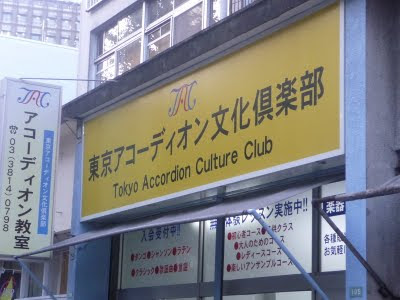
Really? That's NOT what I'm looking for. A bit downhearted, I listlessly walked along a very long wall until I came to somewhere that Moomins might go on holiday.

I walked, saw the fish splash in the pond, I sat down. A leaf fell.

Now I don't think you'll be surprised to hear that the cafe is sort of underwhelming. BUT, there's some good transfers of Tove Jansson's art onto the walls.

And various members of his extended family sitting around waiting for a drink.

Though I don't know, maybe it's me but they more remind me of creatures from the cantina at Mos Eisley in 'Star Wars'. Not the puppets themselves, but I dunno, it's something about the way they are sitting... their attitude.
And this was a BIG mistake: putting a picture of Snufkin on the piece of plastic that they attach the bill to... a Hemulen perhaps, maybe even the Groke, but Snufkin? Never...
**************************************************


